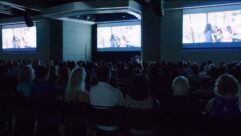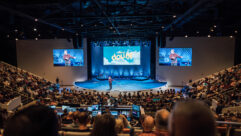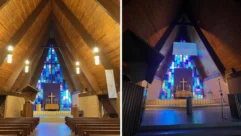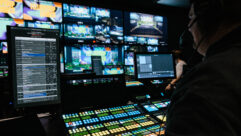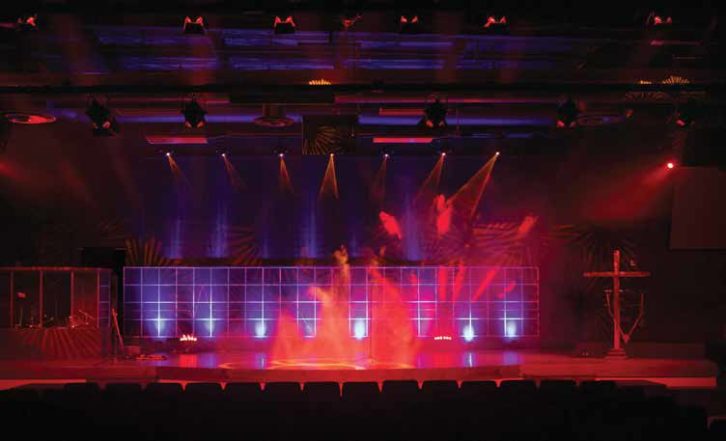
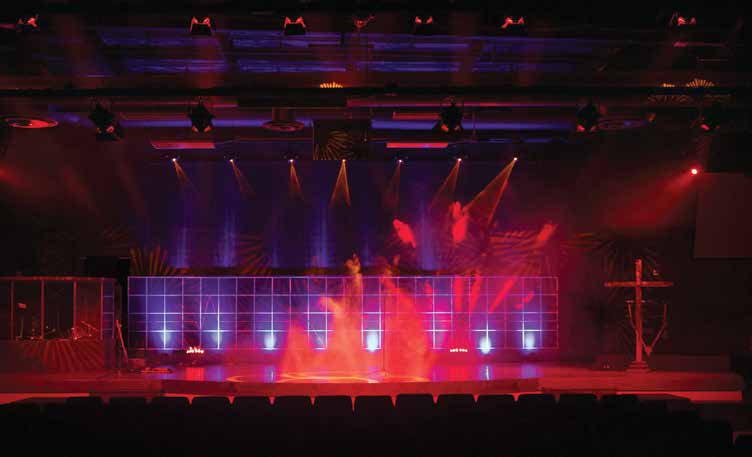
SVC: Is there a particular type of project Axia specializes in?
Bryan Cole: Yeah, there is and it’s taken a while to formulate it, but we really do that interesting niche of servicing the church, the house of worship market, and it’s usually via referral; pastor to pastor. We go wherever the referrals go.
You were working in Hawaii very recently. Tell me about the church you were working on.
That was Inspire Church. They were the first church that invited us to Hawaii and that’s now branched to quite a few more churches on the Islands – on several islands. They are real cutting-edge contemporary. If you’re familiar with the church market, a very Hillsong-esque kind of style. We love working with them and we’ve been working with them now for about three and a half years.
And that’s Inspire Waikele Church?
Yes. Waipahu is the actual town that it’s in. The city next door is called Waikele and it has a shopping mall which is where it is. It’s called the Waikele Outlet Center.
What sort of church is this? Are they a fairly modern congregation?
Very modern. Very modern. If you’re not familiar with the church and you walk in and it wasn’t on a Sunday, you’d think you were in a nightclub.
Alright, so lots of live music.
Lots of live music, rock-and-roll style lights – everything – video, the whole bit.
Okay, so the lighting for this has got to be fairly involved, I mean they’re not just lighting a Sunday sermon. They’re doing live music with all that it brings along.
Correct. Yeah, there’s over 20 motion lighting fixtures in this installation.
So what were they doing previously for a lighting system? Why did they need a lighting upgrade at this point?
They had a traditional dimmer rack installed when they took over the facility about eight years ago. And of course it’s all incandescent. I’ve been working with them for a while and encouraging them not to spend any money upgrading the incandescent lighting infrastructure. I mean just wait until they had the budget to move to LED. And we finally did that, but in that period of time, the quality they were looking for was growing and they were becoming more and more frustrated with the lack of lighting control and the lack of even lighting on the stage.
And this would certainly enhance the worship experience but they also have other things, some youth camps going on there?
They do. They have four conferences every year wherein they invite speakers from around the globe. You know, it’s mostly pastors and leaders from churches on the Island, but there’s a fair amount of people that come from the Mainland as well. It’s a big production. They do it real, real well so they have a high level of production standard and whenever they do any technical infrastructure improvement they’re always thinking about it being a driving tool for conference.
And so the crew there probably has some presets all programed so they can just punch them up for the normal events.
Yeah. Most of the worship songs that they perform are using a backing track so they’re very consistent speed and tempo. Most of the lighting cues are designed specifically to each worship song, so it’s not quite push-button, but it’s pretty close in that a normal volunteer can actually run 20 motion lights with ease on a Sunday morning.
And you selected elektraLite for this. And I believe one of the ones you used the most is the 1018-AI stage light. That’s a 12-Watt, six-in-one LED. So what color LEDs do they have in this one?
Okay, so rather than being just a traditional red, green, and blue LED fixture these also have white, amber, and indigo. So they can do a pure white without projecting color out of the fixture to blend together to make white. And also with the RGB color palette it tends to be somewhat deficient in ambers and the deep purples and so that’s where the indigo and the amber LED come in. So it gives a really, really full spectrum of color not only for color, but also it allows them to have pretty infinite control over the color temperature of the white.

So when you get into the colors on this, that might be simple enough but you’re not the only one looking at it. Apparently they have streaming video so you’re also lighting for a camera.
That’s correct. And that was really the driving force behind the upgrade because they were sort of lighting for their stage because they had added the video component at a later date since their initial system was installed eight years ago. The lighting was uneven so when you’re pointing a camera and panning across a stage, if the lighting level isn’t consistent it’s very noticeable. The camera operator has to adjust the iris on the camera to make sure that it looks consistent on the live stream as well. So they were having challenges with that.
So I would think the video people liked the 1018’s then.
They absolutely loved it. Yes, they sure did. They were quite impressed that we were able to get the color that even. And because it’s a wash fixture, meaning it doesn’t have a very defined edge, it works very, very well to point a bunch of them at a stage and evenly space them and maybe put some shutters on them to make some minor adjustments. But the end result was very even.
Okay. I figure they stay pretty tame with the lighting on the sermons, but when things really get going in there they use the ML-602 moving profile spots?
That’s correct, yes. For the most part the ML-602s are used for worship affect. Every once in a while if they have a drama or a stage act it will be used as a moving head spot where it can be programmed for a particular artist on the stage to be in a certain spot and maybe give them a spotlight. But for the most part it’s just motion. They do haze the room out for the worship part of the service. So really what they’re looking for is a moving head fixture is lighting the haze more than actually pointing at something.
And you’ve got a couple of LOS-1 Lightstream Quad LEDs?
That’s a fun one and I’ve kind of taught them to use it carefully because it’s a very powerful effect. But many times you go to a concert and you’ll see a laser that emanates from the back of the stage up over the crowd. This is a very, very similar effect to that. It’s not the pinpoint light of a laser, but it’s the same kind of scanning effect that you can do with a very basic laser in addition to having color.
How did you mount those?
They’re not actually officially mounted. They’re just ground stacked on the very back of the stage, kind of behind the musicians. And generally they scan upward from crowd height up into the ceiling.
What else do you have in that lighting system now?
The only other thing we’ve provided, again we keep it simple, is we use the elektraLite eyeball, the 5-in-1 which means 5 LEDs; red, green, blue, white and I believe indigo. There’s a few of those hanging from the lighting truss, but more than anything those are just used, for example, inside the drum enclosure, sitting on the stage, just balancing on that. They have a two-part yoke mount so you can really easily just sit them on the stage and aim them up at a musician and provide sidelight, things like that. They’ve probably got about 20 of those that they pepper around and they move them quite a bit. So they do like to change the setting of the stage every, you know, maybe three months or so they’ll move them around.
So how do they control all of this? Where’s the lighting control point?
Well, they have a media booth out towards the back of the sanctuary as many churches have where they combine sound, video, and lighting all into one place. They have an Avolites Tiger Touch II console which they’ve had for about a year now and they absolutely love it.
And they can power up all of these things and control the movers from there? Correct. It’s all from a single point.
And how did you get power to all these new instruments? Did you have to do anything, let’s say, heroic on the power to get it run everywhere the new system needs it? Well actually they had a pretty solid incandescent lighting infrastructure in place already where they had Edison jacks up in the ceiling at various places and dimmer channels marked and all that. So they had an infrastructure that worked well for incandescent lighting. Well when you go to LED of course that changes the game considerably. LED lights are intelligent fixtures and they require full power all the time plus a data signal. But thankfully you have the ability to configure these dimmer racks to really just be on and off channels. So you’re not trying to dim the channel anymore, you just want to turn the power on and off. And it kind of makes an inexpensive way to use the existing infrastructure if it’s still in good shape to then turn the lighting off at the end of the service and save wear and tear on the power supplies and the fans and such like that. So we actually just used what was there. We have a future phase that’s coming up where we’ll be replacing the power control system with a Lyntec relay panel.
The really fun thing must have been once you got it in and showed it to the congregation and the tech crew. What was their reaction when you did the demo on this new lighting setup?
Thankfully they were really pleased. I like to provide technical infrastructures that allow the artists that exist in the organization to do their thing. They have folks there that design lighting cues better than I would ever be able to but they can’t design the lighting system to drive it. So when I was able to give them the tools and they were able to take their artistry to the next levels, that was the most fulfilling part for me.
How long did all of this take to get everything installed and tested and ready to go for them to do what they can with it?
It was actually pretty quick. We prefer that the church have Unistrut instead of traditional pipe lighting bar and this church had, based on our recommendations, built a Unistrut grid at some point in the past. And then the Light Source makes a really cool device called the Uni-Bolt that literally just sticks up into the Unistrut and tightens with a thumb wheel. And then for all of our data signal we use DMX 5 pin to RJ45 adapters and then we use an expensive network cable to run between the lighting fixtures. And so in truth it took about a day and a half to bring the 1018s up. The motion fixtures they have actually done over time so we started with a few and then added a few more and then a year later we ordered the rest of them and built the system out that way.
You make it sound pretty easy. Was there a particularly challenging aspect to this or part of it that was tough to get done?
We’re really blessed. It went really well. There were some things that we don’t have to worry about at Inspire Church that made it go quickly. There’s an LED wall that we installed for them that’s their main video screen and because of the brightness of that we didn’t have to be concerned too much with lighting fixtures washing into projection screens and such like that. So a bunch of things were in our favor on this project and it just went really quickly.
So you can let them go with it. Now, who heads the lighting crew there that you handed the system off to?
Clint Chinen is the technical director for the church and he has several folks on his team that kind of specialize in lighting but it all comes under his watch.
Well I’m sure they have fun with it especially with all the live music.
They do. They have a lot of fun.


